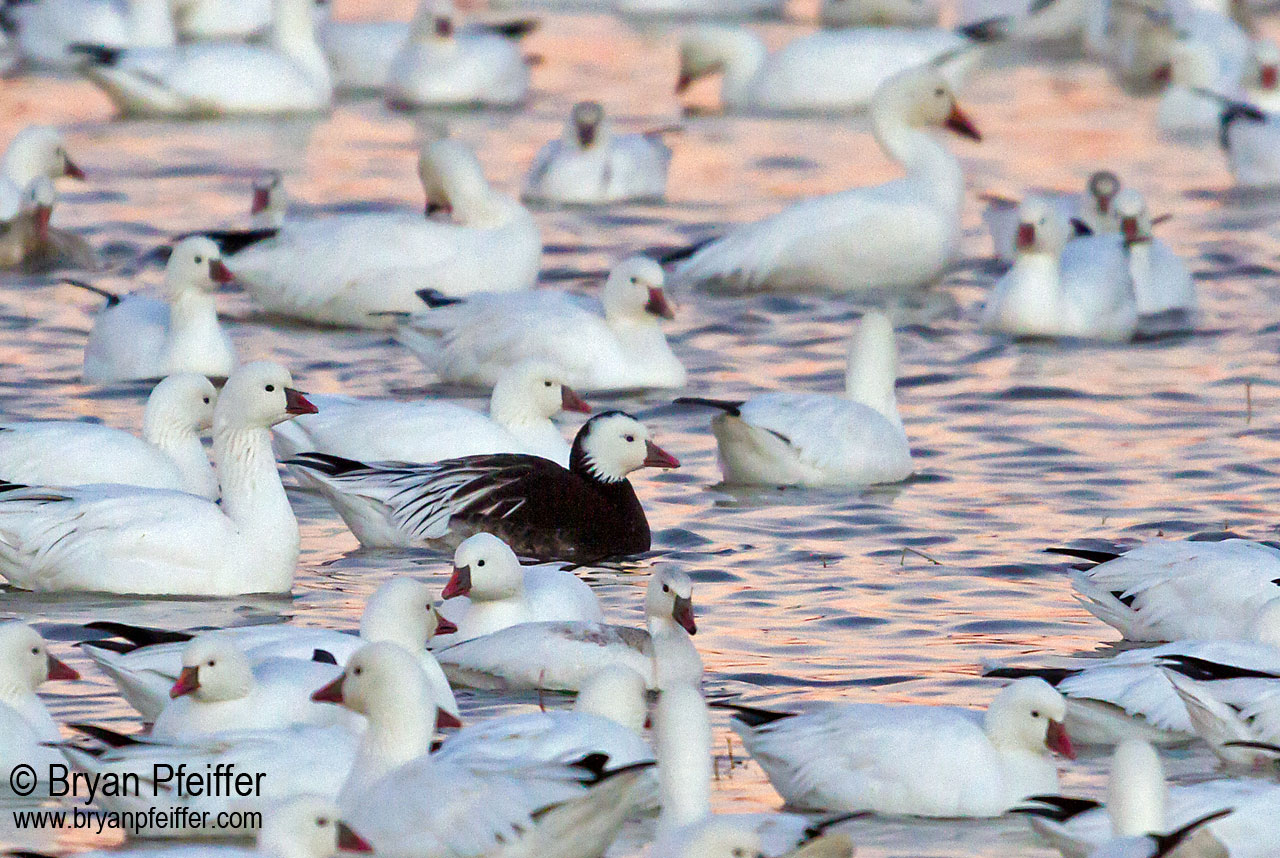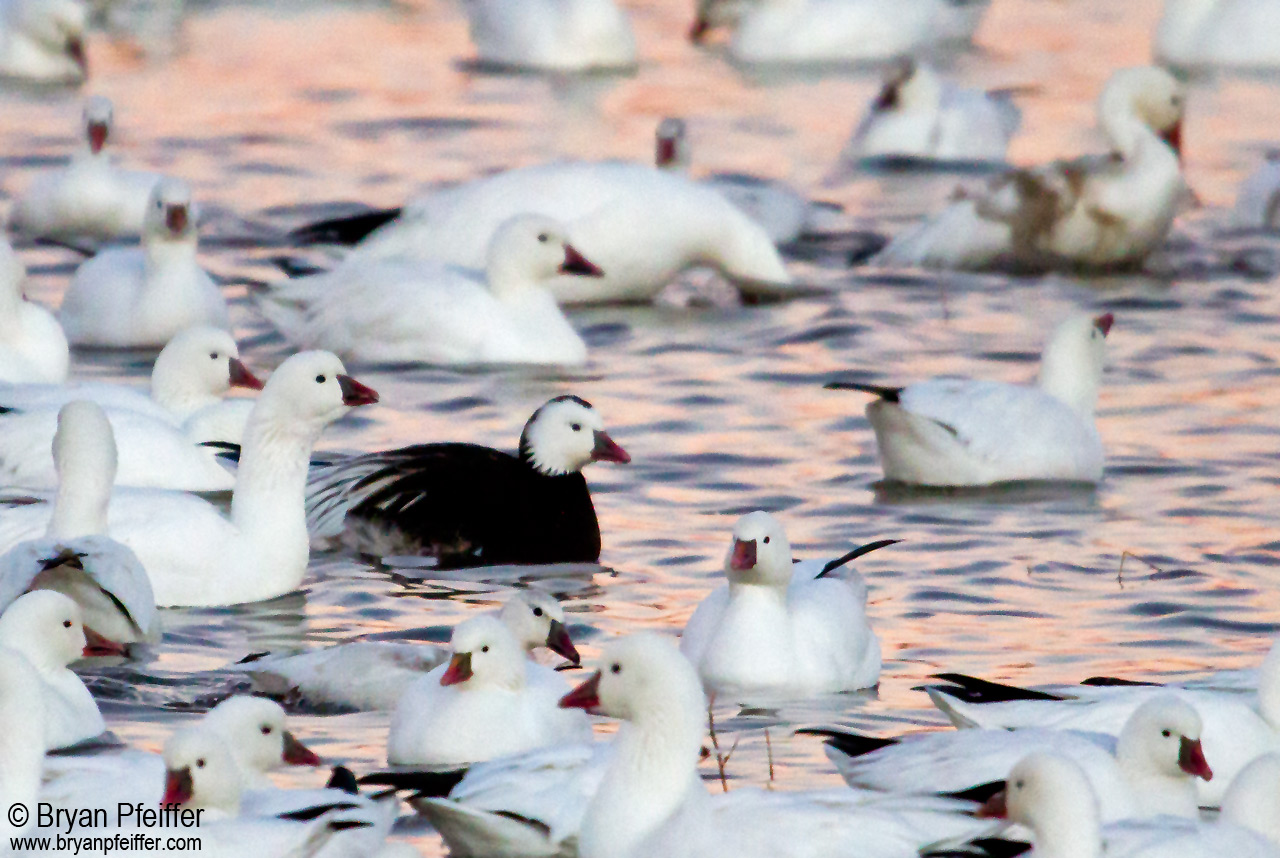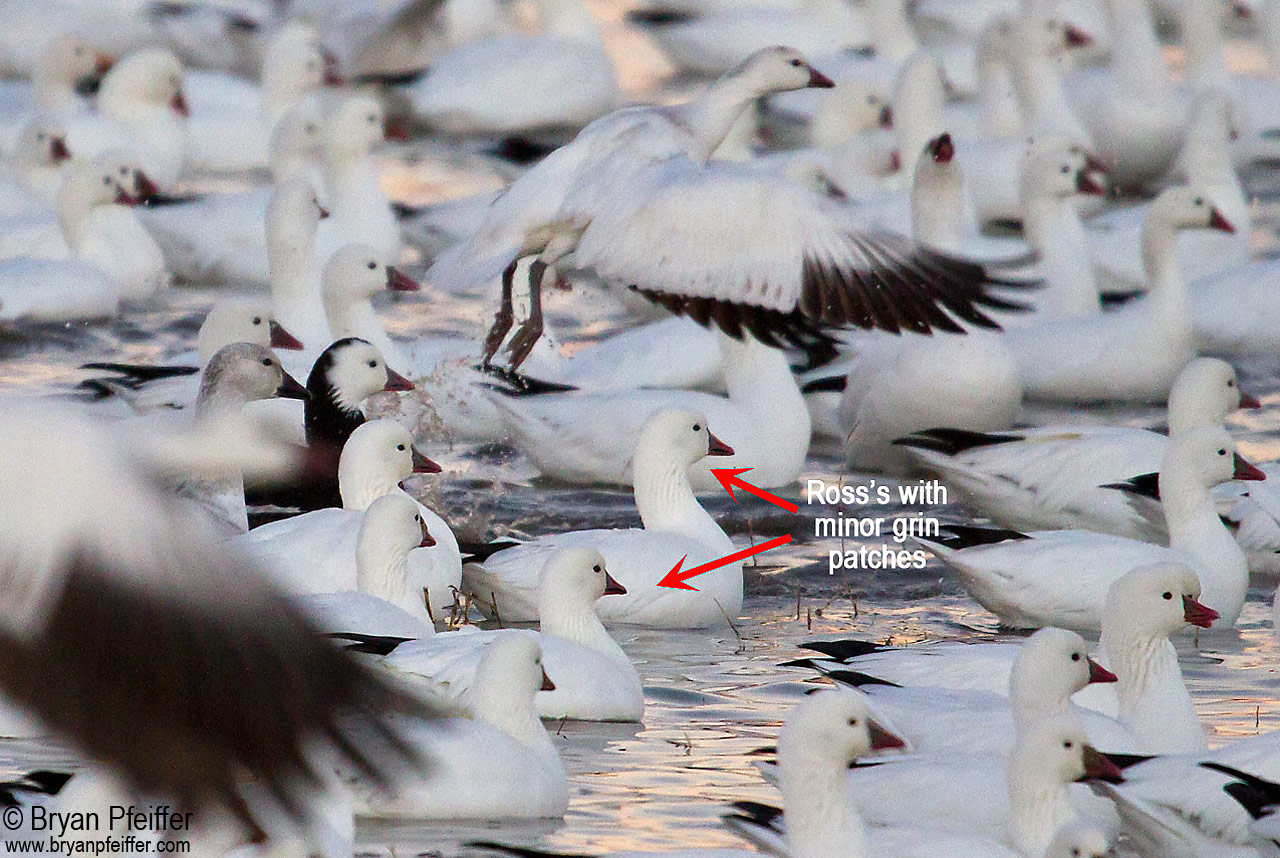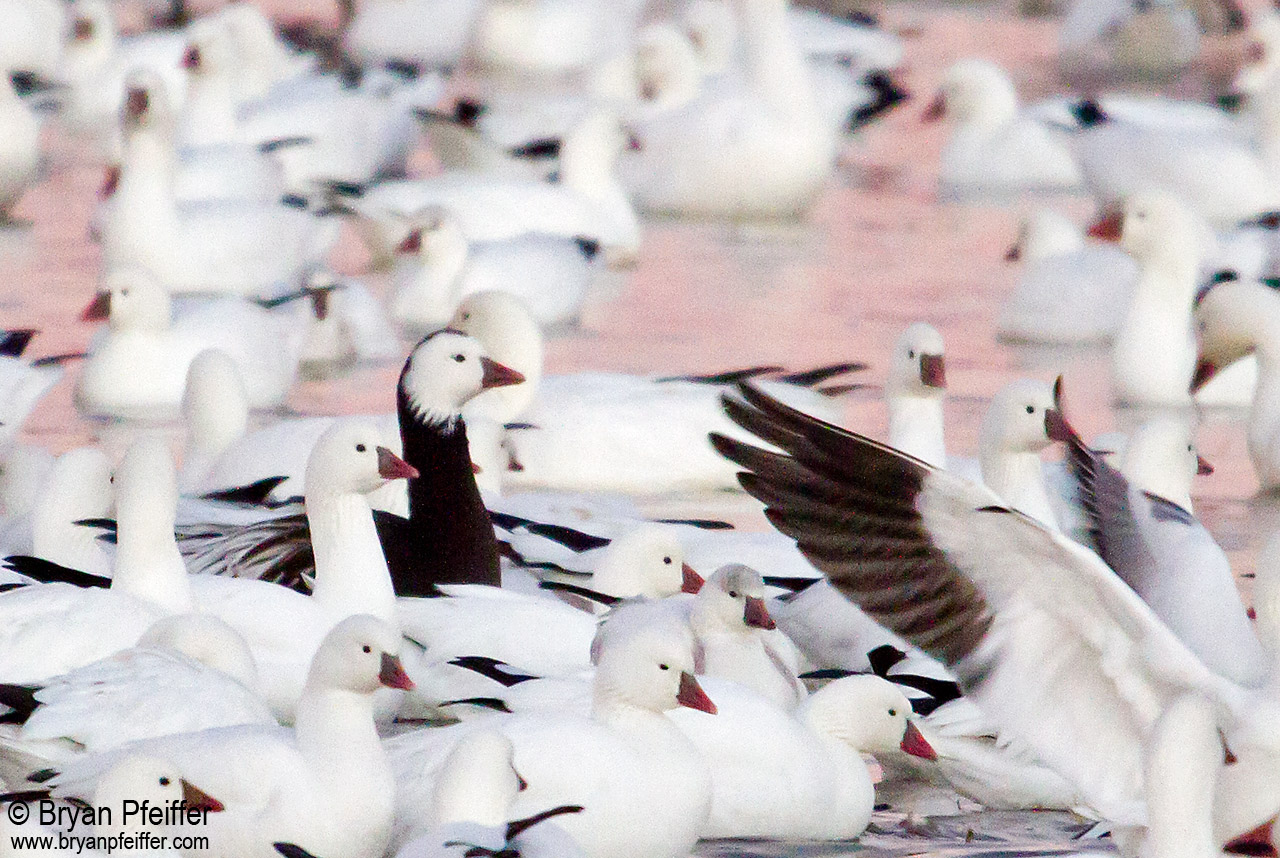A Blue Ross’s Goose
Better Birding Through Geese Identification
At dawn on December 1, 2014, I photographed this blue-morph goose among Ross’s geese at Bosque del Apache National Wildlife in central New Mexico. Is this a Ross’s Goose? Or does it have Snow Goose in its lineage? Read on for a lesson in the finer points of bird identification.
Blue Ross’s Goose is exceedingly rare. And the morphology of this bird’s head and bill suggest that it might be a hybrid or backcross involving a blue Lesser Snow Goose. Here’s the evidence for that:
- White feathering extends out onto the basal area of the bill in an arc slightly more pronounced than what we normally see on Ross’s Goose, which shows a near-vertical demarcation where the feathers meet the base of the bill and which you can see on the other Ross’s geese in that image above.
- The bird’s forehead appears slightly more sloped than the standard steep slope on a Ross’s Goose.
- My bird’s bill may be a few millimeters longer than the other bills in this image (although this is tough to judge) and it seems to show less blue wash at its base (although the blue is more apparent in images below).
I’ve seen plenty of Snow Goose—Ross’s Goose hybrids that look far more like a Snow Goose than this one. And I’ve seen various images of birds looking like this and called Ross’s Goose (including here and here and here), although I’m wary of what I see online. Working in favor of this bird being a legit blue-morph Ross’s Goose:
- Blue feathering extends farther up the neck toward the chin and dorsally on the head of this bird than what seems to be the case for a hybrid, which is said to show more white on the upper throat and crown (McLandress and McLandress 1979).
- David Sibley shows a similar gentle arc of white feathering across the base of the bill on a Ross’s Goose in his own images of the variation in such morphology among white geese (Sibley 2011).
- David also reports that the lower mandible is virtually straight on Ross’s, as is the case with my goose (more obvious in images below), and slightly curved on hybrids.
- This bird appears to be no larger than the Ross’s Geese in its company (again, hard to judge and perhaps not disqualifying for a hybrid or backcross).
- In the image below, I’d be more inclined to call the white goose behind my bird a hybrid or backcross. And if you look in the immediate foreground of that same image, you’ll see what seems to be a Ross’s with similar feathering out onto the bill.
- Put this bird among Snow Geese rather than Ross’s Geese, and many of us would call it a Ross’s (whether it’s blue or white), which might say something more about us than about this particular goose.
Finally, at long last, the grin patch. Snow Goose has one. Ross’s does not. Or so we’re told. Ross’s Goose does indeed show a hint of a grin patch — at the very least dark pigment where the mandibles meet. My blue bird has such a hint, perhaps ever so slightly more pronounced than the other birds here. Perhaps not. But have a look at this final image below, with Ross’s Geese showing similar grin patches. And note how straight the lower mandible appears on the blue goose below — and in my final image of this post.
I’m calling this bird a legitimate blue-morph Ross’s Goose. As best I can tell, the origins of the blue morph in Ross’s Goose are undetermined. There does not yet seem to be evidence of a blue allele, obvious in Snow Goose, in the lineage of Ross’s Goose (Johnson 2013). It could be that the blue-morph Ross’s comes about by a mutation, or more likely the result of hybridization somewhere, sometime with Snow Goose. So perhaps all blue-morph “Ross’s Geese” will show traces of Snow Goose lineage. Can I rule out back-cross? Probably not. But having sent these images to other knowledgeable birders, the consensus is blue-morph Ross’s Goose (with a few saying, “no-brainer”).
I’ll leave you with one more image below — my goose at attention before the entire flock launched and, as a result, extending my wonderful encounter with them that morning into another dimension.
Opinions? Please leave them in the comments section below. Thanks!
(By the way, my apologies for the low quality of these images, which were shot in lousy light from far away. I’ve worked them over, mostly with exposure compensation and midtone adjustments, in PhotoShop.)
References:
Jonsson, Jon E., J. P. Ryder and R. T. Alisauskas. 2013. Ross’s Goose (Chen rossii), The Birds of North America Online (A. Poole, Ed.). Ithaca: Cornell Lab of Ornithology; Retrieved from the Birds of North America Online: http://bna.birds.cornell.edu.bnaproxy.birds.cornell.edu/bna/species/162 doi:10.2173/bna.162
McLandress, M. R. and I. McLandress. 1979. Blue-phase Ross’ Geese and other blue-phase geese in western North America. Auk 96:544-550.
Sibley, D. Identification of White Geese. 2011. http://www.sibleyguides.com/2011/12/identification-of-white-geese/ (Accessed Nov. 14, 2015)





Hi Bryan, thanks for the reply. Just to follow up on the putative Ross’s x barnacle goose hybrid which I asked you to look at, I’ve been discussing it with some hybrid experts and their opinion is that my bird is most likely that pairing, though lesser snow x barnacle cannot be completely ruled out. My concerns with the Ross’s x barnacle combination was that the bird has dark flanks and a dark back which neither parents have, which made me lean towards blue lesser snow goose as one of the parents. However dark flanks are apparently typical of Ross’s x barnacle, as is a slightly larger bird than either parent. Presumably the genes for dark flanks are carried by all Ross’s geese but just not expressed in white birds, which would seem odd since blue Ross’s are so rare. However, it’s great to see it with a large flock of wild barnacles. I’d love to know the history of the bird and if one or both parents were wild, or if it’s just the the offspring of feral birds that has joined up with a wild flock, but I guess we’ll never know that. This population of barnacles breeds in Svalbard whereas wild Ross’s are of course from North America so a wild pairing may seem unlikely, though there was an interior Canada goose with the same flock! Thanks again, Colin
Greetings, Colin. Well, that is indeed an interesting goose. But I’m afraid I won’t be of much assistance — I simply don’t know Barnacle Goose as well as I should, nor do I have much experience with its hybrids. But from what I can see here, this does look fascinating — and pretty good for such a hybrid. It’s hard to believe, however, that these two species manage to hybridize, let a lone with a blue morph. So I’m stumped, but nonetheless intrigued. Please keep me posted!
Great article Bryan, very informative. I wonder if you would mind taking a look at a bird that I saw yesterday on the English Solway with 15,000 barnacle geese. The general opinion is that it’s a Ross’s goose x barnacle hybrid but it has dark flanks and dark back which don’t fit either species unless it was a blue Ross’s goose. I’m wondering if it’s actually either a blue lesser snow goose x barnacle hybrid or even a genuine intermediate blue Ross’s goose / Ross’s x lesser snow goose hybrid. I’d love to get your opinion on this. The photos are on my blog here
https://birdingsthelens.blogspot.com/2021/11/apparent-rosss-goose-x-barnacle-hybrid.html
Thanks
Colin
Hi Wendy. Few people normally see blue morph Ross’s Goose. It is exceedingly rare. So just find thousands and thousands of Ross’s Geese, and start combing through them for a blue form. 🙂 Good luck!
Where would you normally see one of these birds, I live in Manitoba, Canada on lake Manitoba with Ducks Unlimited marshland behind us. I don’t have a picture but I’m sure we seen one yesterday I have never seen one before.
Hi Deb,
I haven’t reported a band in quite some time, so I’m not entirely sure about this — but I think this is the site:
http://www.cen.ulaval.ca/gon-gsg/en_description.php
Please keep me posted!
Hi Bryan, and thank you for posting this great information. As a result, I was able to visit Rouse’s Point for the snow goose sighting of my lifetime!
I took a photo of a goose with a large yellow band (with numbers) on its neck. Is there anyone who might have an interest in the date and location of that bird? I’m happy to send it along.
Thanks.
Great read! I have a bird that I believe is a Blue Morph Ross’.
I would like to send you a pic of it to have you verify.
Does the difference in the eye of your goose make a difference in your determination as to its lineage?
Reg
Awesome! I hope to make it out there some day.
Yeah, I did see that, Bill. I like the first one for hybrid and the second for Ross’s. By all accounts so far, I’m going with Ross’s on mine, which was my initial call. I’m hading back there to Bosque for more!
Hi Bryan – Have you seen this webpage? Same place (different date), same dilemma, additional photos: http://www.wildphotosphotography.com/WildPhotos/RossGoose/BMRoss.htm
Wow! Cool!
Rollin